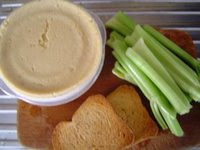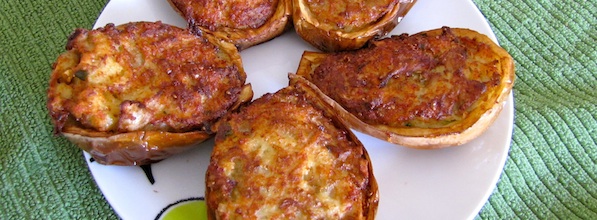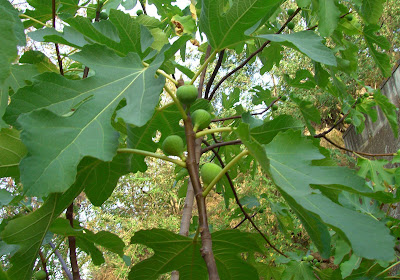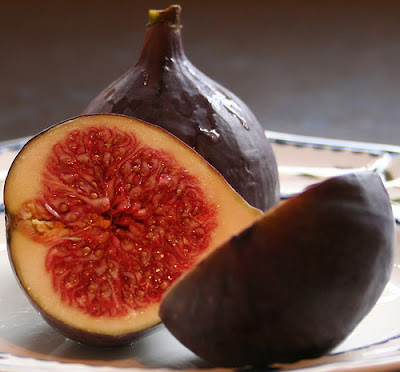Archive for the ‘food’ Category
Recipe: Pasta all Norma
I apologize in advance to those who expressed their dislike of eggplant/aubergine when I stuffed them a few weeks ago…because we’re going at the melanzane again today.
For this week’s What’s Cooking Wednesday, we’re pairing them with tomatoes, basil, garlic, onions, and pecorino cheese in Pasta alla Norma, a Sicilian dish whose origins are in dispute (read more here) but always involve Catania‘s own Vincenzo Bellini and one of his most famous operas, “Norma.”
I should probably add an “alla Sognatrice” at the end of the name of this dish because this is my take on the traditional recipe, which includes a kind of cheese called ricotta salata. It’s not all that easy to find, so I substituted pecorino, as did blogging buddy Sara over at Ms Adventures in Italy recently.
Other differences: some recipes call for sliced eggplant, but I prefer it diced, and almost all require you to crumble the ricotta salata cheese–I could’ve done that with the pecorino, I suppose, but I prefer it grated.
You’re free to do as you like of course.
Pasta alla Norma
4 small eggplants, cut into 1/2 inch cubes
Salt
3 tablespoons olive oil
1 small onion, chopped
3 cloves garlic, minced
Peperoncino to taste
1 can of diced tomatoes
8-10 basil leaves, torn
Spaghetti or penne pasta
Wash and dice eggplant. Place in colander and salt well, being sure to coat all sides (use coarse salt if you have it). Let sit for about a half hour and then remove eggplant from colander and pat dry.Heat olive oil in skillet over medium heat. Add eggplant and cook until brown on all sides, about 10 minutes.
Add onion, garlic and peperoncino, and then after a few minutes, add tomatoes. Let simmer for about 15 minutes or until the tomatoes are done to your taste.
In the meantime, prepare pasta in large pot of boiling water.
When sauce is just about finished, add basil, and then combine pasta and sauce–enough to coat the pasta.
Serve immediately with cheese on top.
Buon appetito!
what’s cooking wednesday: pasta all’amatriciana
Just in time for our cooler, rainier autumn days, today’s What’s Cooking Wednesday is simple, stick to your ribs goodness–Pasta all’Amatriciana, so named because it hails from a town called Amatrice, outside of Rome.
What follows is our interpretation of this recipe in my house. We use penne instead of the traditional bucatini, but we do use pancetta arrotolata like most recipes for this call for. Oh and we add just a touch of garlic.
What’s pancetta arrotolata you say? Well, it’s just rolled pancetta, and it looks like this:
You can read more about it here, but now I’m going to tell that we, lovers of all things spicy, don’t actually add any of our wonderful peperoncino to this dish–we just buy the spicy pancetta instead. See that reddish orange tint inside the rolls? That’s hot, and by that I mean piccante and not Paris Hilton-y.
As a substitute meat, you can use anything similar–we also prepare this recipe with Calabria’s most famous salami, soppressata, or even capicollo (and then add peperoncino). Just keep it chunky and spicy, and yum.
We’re lucky here in Calabria since its tradition of curing meats dates back to the days when Greeks first colonized this area–we’re talking B.C. So yes, they know what they’re doing, and the results are always fabulous.
For those of you lucky enough to be near an Italian market, do make the effort to seek out some of these meats. They’re great in antipasti and also as ingredients in a wide variety of dishes.
Like many Calabrian-Americans, we always had soppressata in our basement in America–my grandfather (non-Italian!), father, and brother would make them and we’d dig in for a Christmas-time treat. Sliced reeeeally thin with some fresh bread is my favorite. Anyone else?
Interestingly but not surprisingly, the local butcher who provides the spice mix to make the “soupies” as we called them (among Calabrians, “soppressata” becomes “suppressata,” and Americans love to make little nicknames, right?) has origins in Isca, which I wrote about yesterday.
So you see, I was also lucky in America.
Pasta all’Amatriciana
2 tablespoons olive oil
1 small onion, diced
1 garlic clove, diced
100 grams pancetta arrotolata,
unrolled and cut into bite-sized chunks
1 tablespoon freshly chopped parsley
1 can peeled tomatoes
500 grams penne pasta
water and salt to boil pasta
grated pecorino romano cheese to garnish
First put on the water to boil for the pasta, and then chop all your ingredients as described above.Put olive oil in skillet and heat on medium. Add pancetta, and let cook for about five minutes, until the pancetta renders its fat. I know, yum, right?
Then add the onions and cook until translucent. Add garlic and parsley and let cook for another minute or so.
At this point, your water should be boiling, and you can add salt and the pasta to the water (or do this whenever your water *is* boiling after this point).
Now add the tomatoes to the skillet. You can run them through a grinder or roughly chop them first depending on how you like them. You can also add some of the pasta water to thin out the sauce a bit; I usually use about 1/4 cup.Let the sauce simmer for about 1o minutes or until the tomatoes taste done to you. You can add salt, but do so sparingly because the pancetta is salty and you’ve also added salted pasta water.
When the pasta is just short of al dente, remove, strain, and combine well with the completely cooked sauce, still over medium heat.
Once the pasta has absorbed some of the sauce and become fully al dente, remove and serve immediately. Garnish with grated pecorino romano cheese.
A note:
Don’t worry if your timing isn’t exact the first time you make this–it’ll get easier the more you make it, which is only more incentive to keep pancetta in your fridge.
Buon appetito!
—————
[tags]pasta, pasta all’amatriciana, pancetta, pancetta arrotolata, cooking, recipes, what’s cooking wednesday[/tags]
What’s Cooking Wednesday: Hummus Without Tahini
Today’s What’s Cooking Wednesday has little to do with Italian food except for the fact that one of the usual main ingredients of hummus can be difficult to find for some of us in Italy.
When Sharon of Respiri Di Vita posted a recipe for tahini-less hummus last week, I was pretty sure this would quickly become a staple in my house.
And it has, so I’m sharing it with all of you because I love it *that* much. This is word-for-word from Sharon’s recipe as there’s nothing I would change even a bit. That’s even her pretty photo!
Sharon posted a week full of quick, delicious recipes recently, so do go have a look.
Hummus Without Tahini
 1 16 oz can of chickpeas or garbanzo beans
1 16 oz can of chickpeas or garbanzo beans
1/4 cup liquid from can of chickpeas
3-5 tablespoons lemon juice (depending on taste)
1 tablespoon peanut butter
2 cloves garlic, crushed
1/2 teaspoon salt
2 tablespoons olive oil
Drain chickpeas and set aside liquid from can. Combine remaining ingredients in blender or food processor. Add 1/4 cup of liquid from chickpeas. Blend for 3-5 minutes on low until thoroughly mixed and smooth. Taste and adjust to your liking.
Peanut butter, by the way, is now pretty easy to find around here whereas at one time, there was no hope. Of course it costs about 5 euros (7 US dollars) for a small jar, so I always welcome peanut butter donations from my family and friends.
I don’t know if it was Sharon’s own idea to substitute peanut butter for tahini, but it was certainly she who opened up the world of hummus for me in Italy. And I will always be grateful.
Grazie mille Sharon, e buon appetito a tutti!
Calabrian Stuffed Eggplant – Melanzane Ripiene
This recipe for stuffed eggplant is local to Badolato, Calabria, and it’s the most delicious melanzane ripiene I’ve ever had.
Read on...what’s cooking wednesday: figs, figs, figs
A long time ago, when I asked all of you to ask me questions to fill out JennieBoo‘s eight things meme,* Amanda of the always delicious Figs Olives Wine kept it short and sweet:
The most delicious thing you’ve eaten in Calabria. Something that just blew you away when you tasted it.
As it turns out, my answer is also short and sweet, literally.
The fresh fig.
These are some green ones, not quite ripe yet, on our fig tree taken about a month and a half ago (in one of the last photos of my injured camera).
Don’t you just love the shape of fig leaves? I hear Adam and Eve sure did. Hah!
And here is a much better, nay awesome photo of the “black” variety, which I found through a Flickr search and am using here under a Creative Commons license (great way to *legally* use others’ pretty photos! Notice I did this on the Spaghetti Strike post as well):
Click here or on the photo to go and see more photos by Xerones–fabulous. Leave him some comments and let him know I sent you.
But back to the figs, did you know that the fig is one of the first plants cultivated by humans? And they’re good for you too!
I had never eaten a fresh fig before I came here, and man oh man, I had no idea what I was missing. This little seedy (in a good way) fruit is by far my new favorite anything–and like Amanda, I prefer it fresh to any other way.
So that’s my first serving suggestion for figs on this What’s Cooking Wednesday.
How do I eat them? Like P taught me. Cut a cross in the top (the end that used to be connected to the tree) and then peel back the skin one part at a time with the edge of the knife. It’ll come back easily if they’re ripe enough–just do be sure to eat them within a day or two of picking them off the tree. They won’t last much longer than that.
Next, I’m going to point you to my second favorite way to eat figs aside from plain with the juice running down my fingers, and that’s with prosciutto crudo.
Jenn, also known as The Leftover Queen and founder of The Foodie Blogroll, has a great description of this dish here. I was setting up a photo of this about a month ago when I realized my camera was dead, so this is a bit of an emotional plate for me now, but I still love it.
Judy of Over a Tuscan Stove and the Divina Cucina Cooking School in Florence also recommends pairing figs with salami–something I’ve never tried, but sounds tasty as well.
And last but certainly not least, I’m going to go back to the inspiration for this post, Amanda, and send you to her Fresh Figs with Fleur de Sel, Aged Balsamic, and Hazelnuts, which she put up just yesterday, reading my mind on what I was going to talk about today.
So, the fresh fig. Simple, delicious, and quite honestly one of the best things I’ve ever eaten in Calabria or anywhere. I also like them dried and in jams, but fresh? Just. Wow.
Doesn’t need to be complicated to be good folks, so even if figs aren’t your thing or you can’t manage to get them, do try to eat lots of other fresh fruits while they’re still in season.
Pair them with flavors you think would complement one another–sweet and salty is always a good bet. Pears and gorgonzola? Apples and cheddar? Grapes and Parmesan?
Be creative, have fun, and keep an open mind!
You never know when your next favorite food combination could show up.
Buon appetito!
*[For those just joining us, feel free to go back and read parts 1, 2, 3, and 4 of the answers to the questions that were asked.]
—————
[tags]figs, what’s cooking wednesday, figs and prosciutto crudo[/tags]

















